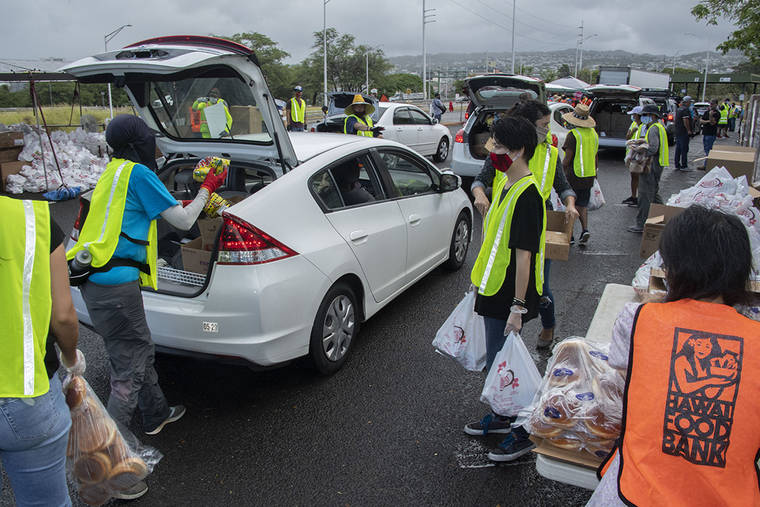Editorial: Hawaii’s food insecurity an urgent problem

CRAIG T. KOJIMA / CKOJIMA@STARADVERTISER.COM
Volunteers load up cars during “Food for Hawaii’s Ohana” food distribution at Aloha Stadium on Wednesday. The event is a public-private partnership to provide food assistance to recently unemployed individuals and families impacted by the coronavirus pandemic.
There’s much to be proud of in Hawaii’s response to a spike in food insecurity springing from the coronavirus Opens in a new tabshutdown Opens in a new tab. Since mid-March, when stay-at-home orders took effect and much of public life came to a halt, efforts to assist people in need have ramped up at a rapid pace.
Some are campaigns involving established food industry professionals working in tandem with nonprofits such as The Salvation Army and Aloha Harvest. Others involve newly formed grassroots community groups.
Also key to the much-needed assist: business sector contributions, government agency guidance and funding, and a vast contingent of volunteers.
The heartening upshots include hot meals going to homebound seniors, grab-and-go options for kids from low-income households who had depended school cafeterias for meals, and thousands of food boxes being distributed weekly to newly needy families.
While this show of resourceful teamwork and generosity is remarkable, sadly, the scope of the apparent need is staggering.
Statewide, nearly 250,000 residents have filed for unemployment in less than two months — about 30% of the state’s labor force. And Hawaii’s overall delivery of unemployment benefits has been sluggish. Further, most of the furloughs and layoffs are in low-wage service worker jobs, hitting many households that were already living paycheck-to-paycheck.
Don't miss out on what's happening!
Stay in touch with breaking news, as it happens, conveniently in your email inbox. It's FREE!
Small wonder that thousands of cars have been lining up hours in advance of “Food for Hawaii’s Ohana” distribution events. Through a public-private partnership including Honolulu Hale, Hawaii Foodbank, Bank of Hawaii and Hawaii Community Foundation, recently unemployed individuals can pick up 50 pounds of free food.
As state lawmakers weigh how to spend the bulk of federal CARES Act funding, it’s encouraging that a small slice — $2 million — is slated to start a program that will allow all families with children who receive free lunches at public schools to also get help from the Supplemental Nutrition Assistance Program (SNAP), better known as food stamps.
Some 24,000 families that are now SNAP recipients, and another roughly 20,000 households, will be added through the new program.
Next month, following a planned recess, lawmakers intend to reconvene at the Capitol to consider additional budget changes and other measures. Among them should be allocation of more funding to address escalating food insecurity.
Well before COVID-19, Hawaii was seeing a rising need for assistance. In recent years, the Hawaii Foodbank has estimated 1 in 5 residents were in need during the year, with many households choosing between paying for food and paying for rent or medicine and medical care.
Waianae Coast Comprehensive Health Center, which started distributing keiki grab-and-go meals when schools were shuttered after spring break, points to pre-coronavirus data gauging 40% of that expansive coast as food insecure.
And a recent report focused on kupuna hunger, issued by the nonprofit Hawaii Appleseed Center for Law & Economic Justice, placed food insecurity in the state’s age 60-and-older group at between 5% and nearly 10% — estimating that at least 16,700 seniors here are at risk of going hungry. An estimated 70% of Hawaii seniors are eligible to enroll in SNAP.
For many households, the coronavirus outbreak is prodding a necessary focus on frugality. Stepped-up pocketbook management and even a bit of gardening can help those contending with economic fallout to recover. Still, the ongoing tireless work of many groups gathering, preparing and distributing sustenance to those in need remains essential.
Hawaii’s post-pandemic recovery likely will be in progress for years. Lawmakers and others should be taking a hard look at short-term fixes as well as long-term solutions for food insecurity.




